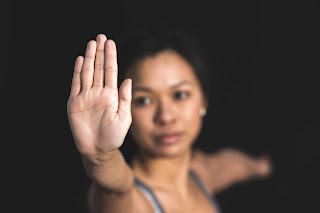How to offer touch to someone who is hypersensitive to receiving it
- Get link
- X
- Other Apps
Receiving touch is something many of us welcome and benefit from but not everyone is so accepting so what happens when someone is hyper sensitive to receiving and accepting touch?
Touch is something that is a basic human need for us all, but what if you are hypersensitive to touch or are affected by ‘tactile defensiveness’ as it can be known and what may have caused this to occur?
Individuals who experience hypersensitivity often say that things that touch their skin bother them more than others. This could include textures of clothes, food, stationary or of course touch and there are a variety of reasons as to why they may be hyper sensitive including hereditary, physical trauma, chemotherapy, drugs, substance abuse, infectious diseases, autism, fibromyalgia, chronic fatigue syndrome, post-traumatic stress disorder and sensory processing disorders.
Whatever the reason may be, it is essential to stay mindful and always compassionate and use a gentle, yet attentive therapeutic touch as the persons body may not be capable of receiving very much pressure for several reasons, such as the ones described above. It is essential to communicate clearly especially during the initial consultation, in addition to the ones following, to become aware of personal boundaries as they will affect where and how the person will be comfortable to receive touch.
A good starting point is to sit facing the person so you are at their height and they can clearly see you. Then explain when and how you will proceed and if they are comfortable for you to do so. Be aware that although they may at first agree to touch in a certain area, they should feel comfortable to change their mind at any point during the session, if it is no longer feeling agreeable or if they become overwhelmed. Go very slowly and at their pace so they remain comfortable, continuing to explain what you will do prior to continuing touching.
A good place to start is by gently resting your hand on top of theirs and then if they are comfortable to proceed, perhaps move onto holding their hand between both your hands for a little while. With permission, continue to touch the body within the boundaries discussed clearly, previously. It is important to note that the person receiving the therapeutic touch will benefit both physically and emotionally. This is because if you are fully present and touching with the correct intention for healing, the energy naturally flows through the giver’s hands and into the receiver’s body, creating a powerful form of nonverbal communication.
When the giver is ready and it feels comfortable to proceed, slowly lift the hand up and away from the person’s body, then wait a few moments so they may experience fully the effects of the touch, before continuing with the same touch or another variation. Each form of touch can be at a pressure that instinctively feels right with you and comfortable with the person who is receiving it. Be aware of any reactions that are expressed as a result, to indicate how the touch is being received and change the intensity or type of touch if necessary. If you are not entirely sure if the touch is comfortable, do not be afraid to ask directly with a question such as ‘Am I pressing hard enough for you or shall I press harder’? A question such as ‘How’s the pressure?’ is a little nonspecific and may not be effectively understood.
For those who are frail or unable to have full range movement of their bodies it can be helpful to focus on specific parts using small and gentle movements, to explore the degree of mobility within the areas of the body connected by joints such as the ankle or wrist. Using an up and down motion or side to side, working slowly and gradually to both create awareness in that specific part but also to provide a gentle form of exercise, thereby improving the circulation in addition to stimulating the brain for added benefits.
Unless you are a trained and experienced massage therapist it is preferable to avoid using more advanced techniques to explore the full range of movement for safety reasons. However, it can be beneficial for the receiver if they are able to explore with you their own levels of comfort and limitations, asking questions such as ‘how high can you lift this arm?’ which they can then try to do, ideally with no assistance from you. This will not only provide you with a sense of awareness and a guide, to their limitations, but in addition will provide a sense of control, progress and most importantly accomplishment to the receiver.
It is important to remember to balance the body throughout the session, therefore ensure that both sides of the body receive equal attention and physical stimulation, this also applies even if sensation is felt on only one side by the giver, for example in the case of a stroke, or if a limb is missing from the body. Just continue to focus therapeutic touch into the parts that you are able too, with prior permission of course.
The power of touch alone can convey so many feelings and emotions, but when it’s combined with emotional support the sensations and benefits experienced are greatly increased. It is important to be aware however, not to hold the contact in one place for too long ,to ensure the benefits of touch can be equally received on other parts of the body also. It can be reassuring to the giver also, if the pattern of touch starts and ends at the same place to provide reassurance and a sense of completion and the hands are an ideal place to put this guideline into practice.
For many of us touch is something we take for granted and yet for others particularly if they are coming towards the end of their life, it may not be appropriate at that time as that person may already have desensitized themselves and disconnected physically from their body. In cases such as these ,it is important to recognise that this is still an individual person with their own needs and not just another physical body. It may give more comfort to simply use very gentle touches with the fingertips, perhaps at the base of the feet or top of the head, or by placing the hand on top of the wrist or ankle to bring a sense of peace and reassurance. It is important to constantly be aware and conscious, to understand that the most simple and gentle of touches can often mean the most, such as holding their hand to provide a sense of care and support , especially in those important final moments.
Elizabeth Lock Professional Cuddle Therapist
www.yourcuddletherapy.co.uk heal@yourcuddletherapy.co.ukwww.yourinnerglow.co.uk heal@yourinnerglow.co.uk
www.yourcuddletherapy.co.uk heal@yourcuddletherapy.co.ukwww.yourinnerglow.co.uk heal@yourinnerglow.co.uk
10
- Get link
- X
- Other Apps




Comments
Post a Comment